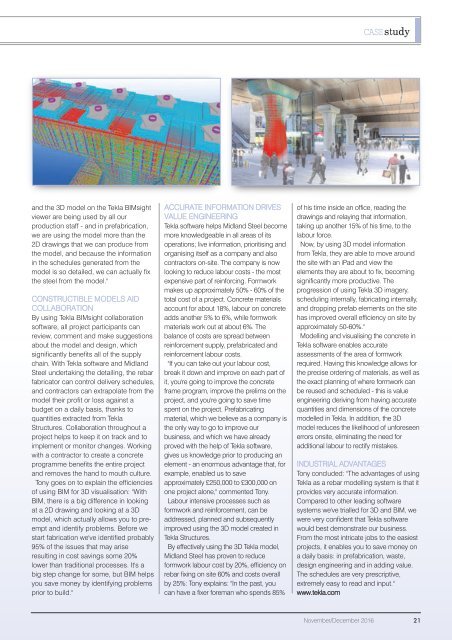Create successful ePaper yourself
Turn your PDF publications into a flip-book with our unique Google optimized e-Paper software.
CASEstudy<br />
and the 3D model on the Tekla BIMsight<br />
viewer are being used by all our<br />
production staff - and in prefabrication,<br />
we are using the model more than the<br />
2D drawings that we can produce from<br />
the model, and because the information<br />
in the schedules generated from the<br />
model is so detailed, we can actually fix<br />
the steel from the model."<br />
CONSTRUCTIBLE MODELS AID<br />
COLLABORATION<br />
By using Tekla BIMsight collaboration<br />
software, all project participants can<br />
review, comment and make suggestions<br />
about the model and design, which<br />
significantly benefits all of the supply<br />
chain. With Tekla software and Midland<br />
Steel undertaking the detailing, the rebar<br />
fabricator can control delivery schedules,<br />
and contractors can extrapolate from the<br />
model their profit or loss against a<br />
budget on a daily basis, thanks to<br />
quantities extracted from Tekla<br />
Structures. Collaboration throughout a<br />
project helps to keep it on track and to<br />
implement or monitor changes. Working<br />
with a contractor to create a concrete<br />
programme benefits the entire project<br />
and removes the hand to mouth culture.<br />
Tony goes on to explain the efficiencies<br />
of using BIM for 3D visualisation: "With<br />
BIM, there is a big difference in looking<br />
at a 2D drawing and looking at a 3D<br />
model, which actually allows you to preempt<br />
and identify problems. Before we<br />
start fabrication we've identified probably<br />
95% of the issues that may arise<br />
resulting in cost savings some 20%<br />
lower than traditional processes. It's a<br />
big step change for some, but BIM helps<br />
you save money by identifying problems<br />
prior to build."<br />
ACCURATE INFORMATION DRIVES<br />
VALUE ENGINEERING<br />
Tekla software helps Midland Steel become<br />
more knowledgeable in all areas of its<br />
operations; live information, prioritising and<br />
organising itself as a company and also<br />
contractors on-site. The company is now<br />
looking to reduce labour costs - the most<br />
expensive part of reinforcing. Formwork<br />
makes up approximately 50% - 60% of the<br />
total cost of a project. Concrete materials<br />
account for about 18%, labour on concrete<br />
adds another 5% to 6%, while formwork<br />
materials work out at about 6%. The<br />
balance of costs are spread between<br />
reinforcement supply, prefabricated and<br />
reinforcement labour costs.<br />
"If you can take out your labour cost,<br />
break it down and improve on each part of<br />
it, you're going to improve the concrete<br />
frame program, improve the prelims on the<br />
project, and you're going to save time<br />
spent on the project. Prefabricating<br />
material, which we believe as a company is<br />
the only way to go to improve our<br />
business, and which we have already<br />
proved with the help of Tekla software,<br />
gives us knowledge prior to producing an<br />
element - an enormous advantage that, for<br />
example, enabled us to save<br />
approximately £250,000 to £300,000 on<br />
one project alone," commented Tony.<br />
Labour intensive processes such as<br />
formwork and reinforcement, can be<br />
addressed, planned and subsequently<br />
improved using the 3D model created in<br />
Tekla Structures.<br />
By effectively using the 3D Tekla model,<br />
Midland Steel has proven to reduce<br />
formwork labour cost by 20%, efficiency on<br />
rebar fixing on site 60% and costs overall<br />
by 25%: Tony explains: "In the past, you<br />
can have a fixer foreman who spends 85%<br />
of his time inside an office, reading the<br />
drawings and relaying that information,<br />
taking up another 15% of his time, to the<br />
labour force.<br />
Now, by using 3D model information<br />
from Tekla, they are able to move around<br />
the site with an iPad and view the<br />
elements they are about to fix, becoming<br />
significantly more productive. The<br />
progression of using Tekla 3D imagery,<br />
scheduling internally, fabricating internally,<br />
and dropping prefab elements on the site<br />
has improved overall efficiency on site by<br />
approximately 50-60%."<br />
Modelling and visualising the concrete in<br />
Tekla software enables accurate<br />
assessments of the area of formwork<br />
required. Having this knowledge allows for<br />
the precise ordering of materials, as well as<br />
the exact planning of where formwork can<br />
be reused and scheduled - this is value<br />
engineering deriving from having accurate<br />
quantities and dimensions of the concrete<br />
modelled in Tekla. In addition, the 3D<br />
model reduces the likelihood of unforeseen<br />
errors onsite, eliminating the need for<br />
additional labour to rectify mistakes.<br />
INDUSTRIAL ADVANTAGES<br />
Tony concluded: "The advantages of using<br />
Tekla as a rebar modelling system is that it<br />
provides very accurate information.<br />
Compared to other leading software<br />
systems we've trialled for 3D and BIM, we<br />
were very confident that Tekla software<br />
would best demonstrate our business.<br />
From the most intricate jobs to the easiest<br />
projects, it enables you to save money on<br />
a daily basis: in prefabrication, waste,<br />
design engineering and in adding value.<br />
The schedules are very prescriptive,<br />
extremely easy to read and input."<br />
www.tekla.com<br />
November/December 2016 21

















